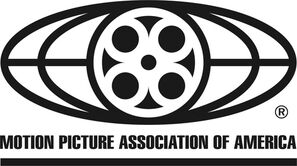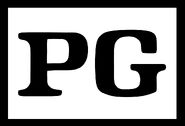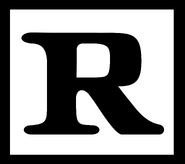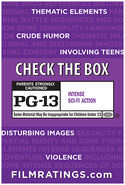The Motion Picture Association (MPA), formerly known as the Motion Picture Association of America (MPAA) (1945-2019) and the Motion Picture Producers and Distributors of America (MPPDA) (1922-1945) is the main rating system in America.
Ratings[]

The former logo used from 1922-1946, 1947-1967.

The logo used from 1967-2019.

The current logo used from 2019–present to reflect the global nature of the film, television, and streaming industry.
The current logo was and is in use, starting from 1967. The MPA administers a motion picture rating system used in the United States to rate the suitability of a film's themes and content for certain audiences. The rating system was first introduced on November 1, 1968, and has lived through several changes then. The rating system is completely voluntary, and ratings have no legal standing. Instead, theater owners and state laws enforce the MPA film ratings after they have been assigned, with many previews refusing to exhibit films for six major Hollywood studios.
The ratings currently used by the MPA's voluntary system are:
G (General Audiences - All Ages Admitted)[]
A G-rated motion picture contains nothing in theme, language, nudity, sex, violence, or other matters that, in the view of the Rating Board, would offend parents whose younger children view the motion picture. An example of a G-rated film is The Emperor's New Groove. The G rating is not a "certificate of approval," nor does it signify a "children's" motion picture. Some snippets of language may go beyond polite conversation but they are common everyday expressions. No stronger words are present in G-rated motion pictures. Depictions of violence are minimal. No nudity, sex scenes, or drug use are present in the motion picture. Examples: Cinderella trilogy, Cars trilogy, Wallace and Gromit: The Curse of the Were-Rabbit
PG (Parental Guidance Suggested - Some Material May Not Be Suitable for Children)[]
A PG-rated motion picture should be investigated by parents before they let their younger children attend. The PG rating indicates, in the view of the Rating Board, that parents may consider some material unsuitable for their children, and parents should make that decision. Examples of PG-rated movies include Frozen and Outlander.
The more mature themes in some PG-rated motion pictures may call for parental guidance. There may be some profanity and some depictions of violence or brief nudity. But these elements are not deemed so intense as to require that parents be strongly cautioned beyond the suggestion of parental guidance. There is no drug use content in a PG-rated motion picture. Examples: Percy Jackson and the Olympians: The Lightning Thief, The Greatest Showman, How to Train Your Dragon trilogy
PG-13 (Parents Strongly Cautioned - Some Material May Be Inappropriate for Children Under 13)[]
A PG-13 rating is a sterner warning by the Rating Board to parents to determine whether their children under age 13 should view the motion picture, as some material might not be suited for them. One example of a PG-13-rated movie is The Incredible Hulk. A PG-13 motion picture may go beyond the PG rating in theme, violence, nudity, sensuality, language, adult activities or other elements, but does not reach the restricted R category. The theme of the motion picture by itself will not result in a rating greater than PG-13, although depictions of activities related to a mature theme may result in a restricted rating for the motion picture. Any drug use will initially require at least a PG-13 rating. More than brief nudity will require at least a PG-13 rating, but such nudity in a PG-13 rated motion picture generally will not be sexually oriented. There may be depictions of violence in a PG-13 movie, but generally not both realistic and extreme or persistent violence. A motion picture's single use of one of the harsher sexually-derived words (basically the F-word), though only as an expletive, initially requires at least a PG-13 rating. More than one such expletive requires an R rating, as must even one of those words used in a sexual context. The Rating Board nevertheless may rate such a motion picture PG-13 if, based on a special vote by a two-thirds majority, the Raters feel that most American parents would believe that a PG-13 rating is appropriate because of the context or manner in which the words are used or because the use of those words in the motion picture is inconspicuous. Despite all this, the PG-13 rating is still unrestricted, meaning persons of any age may view the film without supervision. Examples: The Hate U Give, The Secret Life of Bees, Shang-Chi and the Legend of the Ten Rings, The Avengers tetralogy, Selma, The Great Gatsby (2013 version), Titanic
R (Restricted - Under 17 Requires Accompanying Parent or Adult Guardian)[]
An R-rated motion picture, in the view of the Rating Board, contains some adult material. One example of an R-rated movie is Scarface. An R-rated motion picture may include adult themes, adult activity, hard language, intense or persistent violence, sexually-oriented nudity, drug abuse or other elements, so that parents are counseled to take this rating very seriously. Children under 17 are not allowed to attend R-rated motion pictures unaccompanied by a parent or adult guardian. Parents are strongly urged to find out more about R-rated motion pictures in determining their suitability for their children. Generally, it is not appropriate for parents to bring their young children with them to R-rated motion pictures. Examples: Django Unchained, The Departed, The Revenant, Once Upon a Time...in Hollywood, Shutter Island, Cold Pursuit, Wall Street, Fatal Attraction, A Wrong Turn series, The Last Duel, The Disaster Artist, The Room, 127 Hours, Kingdom of Heaven
NC-17 (Adults Only - No One 17 and Under Admitted)[]
An NC-17 rated motion picture is one that, in the view of the Rating Board, most parents would consider patently too adult for their children 17 and under. One example of an NC-17-rated film is The Secret Sex Lives of Romeo and Juliet. No children will be admitted. NC-17 does not mean "obscene" or "pornographic" in the common or legal meaning of those words, and should not be construed as a negative judgment in any sense. The rating simply signals that the content is appropriate only for an adult audience. An NC-17 rating can be based on violence, sex, aberrational behavior, drug abuse or any other element that most parents would consider too strong and therefore off-limits for viewing by their children. Examples: Henry & June (first film to be rated NC-17), The Evil Dead, Showgirls
| MPA | ESRB | TVPG | ACB |
|---|---|---|---|
| G | E | TV-G / TV-Y / TV-Y7 | G |
| PG | E10+ | TV-PG / TV-Y7-FV | PG |
| PG-13 | T | TV-14 | M |
| R | M | TV-MA | MA15+ |
| NC-17 | AO | n/a | R18+ |
Notes[]
The MPA does not enforce the age restrictions of the R and NC-17 ratings since it has no power to do so. Instead, the restrictive MPA ratings are legally enforced by state and federal laws.
Controversies[]
- The MPA has been accused of being homophobic, because of their tendencies to rate films with homosexual sex an NC-17.
- The MPA has been criticized by the fact that using more than one use of "f**k" without reasonable context is enough to push a film to the R rating. Many kids and teenagers nowadays use the expletive daily, meaning that making a film rated R purely based on language is unnecessary.
- Some people criticized the MPA's decision to rate The King's Speech R due to language, even though there is reasonable context, since giving the movie the R rating gives it the same rating as far more inappropriate movies like Saw or Final Destination, both of which are gory movies. The BBFC on the other hand gave the movie a 12A/12 rating due to "strong language in a speech therapy context".
History[]
Out of these, G and R are the only two ratings to survive since the system's debut. The other was changed from its debut until now. The following applies:
- M (1968-1970)
- GP (1970-1972)
- X (1968-1990)
The PG-13 rating was added in 1984, officially putting former words on PG to PG-13, and now PG changed its wording.
NR[]
However, there are some movies that haven't been officially rated by the MPA, hence "NR" for "Not Rated"; however, this usually occurs if the movie has not made its debut in the theaters or if the uncut version is released. The ratings are below: Please keep in mind that the NR rating means that the upcoming movie has not yet been reviewed by the MPA, later they will give the films its final rating. Equivalent to RP for video games.
Gallery[]
| Motion Picture Association film rating system |
|---|
     Formerly used ratings: M | GP | X |
















